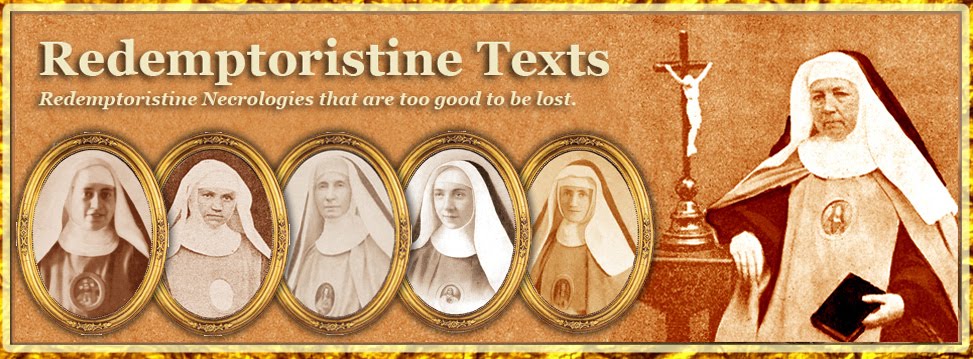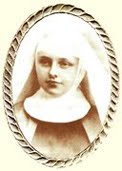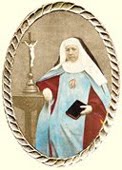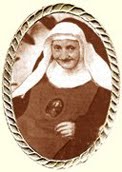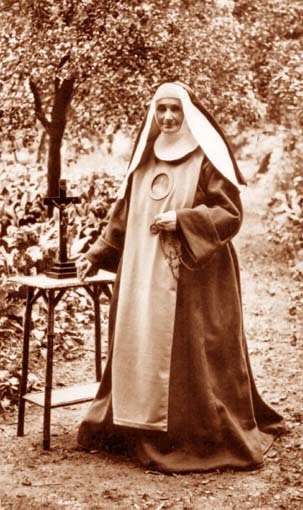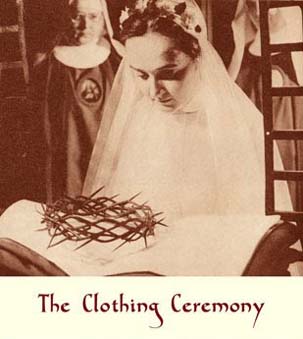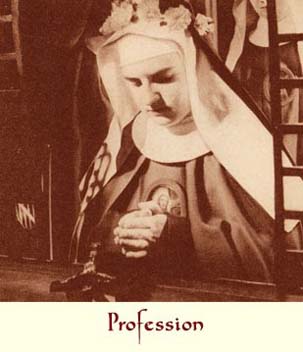1. Her life in the world.
If nobility of blood in itself does not confer any advantage over virtue, however it gives it a singular lustre when it is united to it. And so divine grace shines forth marvellously in those holy souls who make the human greatness that falls to them serve the glory of God.
Sophie Hanmer was born on 22nd July 1819 in Hanmer, Flintshire, in north Wales.[1] Her father, the local Protestant minister, was the son of Sir Thomas Hanmer Bart. Her mother was one of the daughters of Sir Thomas Whichcote Bart, of Aswarby Hall, Lincolnshire. Although the misfortune of the times had dragged them into Protestantism, they nonetheless still preserved a deep esteem for the Catholic religion. Mr. Hanmer was even a great admirer of the Rev. Father. Newman. He saw him for the first time at Oxford in 1839 and was struck by the sanctity of his person. Some days later, he obtained his sermons; but, by a strange contradiction, he who so admired the religion of his forebears, did not want to embrace it and died in heresy.
Young Sophie was therefore brought up in the bosom of Protestantism. At the age of ten, her parents sent her to a house of education in Chester where she was thoroughly versed in literary studies. Her natural talents developed marvellously, and she was admired for her healthy judgment, firm spirit, an elevated reasoning, and an extensive knowledge for her age, and with it, she had a naturally sweet, compassionate and magnanimous character.
When her education had finished, she spent several years in the paternal home and made her entry in the world. At the age of twenty-one, she received from the hands of her parents a husband in the person of Mr. J. L. Ainsworth of Bankside, Oldham. God blessed this marriage by granting them five children, two sons and three daughters.
At about that time (1849), Mrs. Ainsworth’s eldest brother converted to Catholicism: it was for her a painful event, and she believed that her brother, thus separated from his whole family, was lost for ever. She scarcely suspected that he was to become the instrument of her own conversion. Yet, Mr. Hanmer had acted only with discernment. Since he was thirteen, the thought that the Catholic, apostolic and Roman religion, was the only true one, had constantly pursued him. The Protestant environment in which he lived, scarcely permitted him to settle his doubts; but one day, having entered a church during the holy Mass, he heard a sermon that touched him deeply. The priest was commenting on the gospel of the day, the parable of the good Shepherd. He admirably described the union that closely connects the faithful to the Pope, the divinely appointed successor of Saint Peter and Vicar of Jesus Christ on earth, and showed how this perfect unity was the sign of the true Church. Mr. Hanmer was floored: his decision was made; he put himself in contact with the venerable priest whose words had been for him as so many burning arrows, and on 15th December 1849, he solemnly abjured Protestantism. From this day on (these are his own words), the prayer of his heart was, and would always be, expressed in these beautiful words by the glorious martyr, Richard Thirkill, who died for the faith in 1583:
“O merciful Father who has created me,
Oh most sweet Son who has ransomed me,
Oh Holy Spirit who has sanctified me,
Oh Blessed Trinity, three persons and a single God,
Keep me, defend me, govern me in the unity of the Catholic and apostolic Church,
So that I may merit to live and to die within it,
And may to finally be able to enjoy the glory of your divine Majesty:
I ask this through Christ Our Lord.”
This abjuration, as we have said, caused great grief to Mrs. Ainsworth; it also awakened in her a lively remorse. The uprightness and elevation of her spirit had indeed for a long time now been suggesting doubts to her about the truth of Protestantism; but a secret pride prevented her from answering God's secret call. “I am not astonished”, she wrote to her brother, “that many people are captivated by the beauty and ornamentation of the Catholic churches, and their beautiful books of prayers also far surpass those that we have in our Church. However, there are many points that stop me. However, this does not mean that I do not pray less sincerely every day and ask God every day to enlighten me; as I have never told you how much these thoughts preoccupy me. Today, now that this question has been placed so firmly before me, I am in a greater quandary than ever. If, in fact, you are in the truth, I am in error; and vice-versa. I must therefore look to where the truth is. I will not fail to pray that the unity that exists in the Catholic Church may give you peace, this unity that, unfortunately, we do not possess in our own.”
The interior struggle that agitated Mrs. Ainsworth had its outcome. Her brother went to pay her a visit during the summer, and the conversation turned to the fundamental question of the true Church. All of a sudden, the sky was full of clouds, and a terrible storm burst forth: the noise of the thunder lasted a long time, and made a striking impression on Mrs. Ainsworth. She felt that God's great voice was addressing a supreme call to her. When the weather became calmer, and when the rays of the sun, penetrating the room, seemed to make them forget what had happened, the mistress of the house got up. She leaned towards her brother and spoke into his ear: “I can delay no longer, I want to go and see Dr Newman tomorrow: be good enough to accompany me.”
How did this first meeting go? We do not know. What we do know, is that in the space of a few interviews, the famous convert made the truth of the Catholic Church shine in Mrs. Ainsworth’s eyes: he dissipated her doubts, solved her difficulties, and had the consolation of seeing this upright soul surrender to the teachings of the faith with the greatest submissiveness. Of her own initiative and in the full liberty of her heart, she humbly asked to make her abjuration. The ceremony took place on 14th June 1850 in London, in the small church of the Oratorians. Father Newman was happy to introduce into the true Church someone who followed his example and “had not rebelled against the light.” As for the new convert, she felt an inexpressible joy and tasted a peace which she had never had any idea of. Henceforth, from being a simple neophyte, she was to become an apostle.
* * * * *
On the advice of Rev. Father Newman, Mrs. Ainsworth then got in touch with Rev. Father Lans, the Superior of a community of Redemptorist Fathers that had just settled in Hanley Castle in Wales, close to Malvern Wells. The proximity of this castle, the reputation for holiness which the Reverend Father enjoyed and the numerous conversions of which he had been the instrument, more than justified Father Newman’s choice. Events soon proved that Father Lans was indeed the man that the new convert needed to sustain and encourage her in the difficulties that she was about to encounter.
He first of all advised her to have all her children baptized, with their own consent, and afterwards have them instructed sufficiently in Catholic doctrine. He said: “It is best not to delay; as for Mr. Ainsworth, he would not be more displeased with one event than the other.” Mr. Ainsworth indeed, though Protestant in fact, nevertheless venerated the Catholic Church. Being quite addicted to hunting, for which he professed a real passion, he was scarcely moved by the conversion of his pious wife. Moreover, he showed her more than affection and respect: she inspired a veritable veneration in him, by her great qualities, her patience and her goodness. We may say more, he was proud of her and gave way to her will, provided that she left him free to pursue the hunt madly across fields and forests, and invite his numerous friends to his table.
Mrs. Ainsworth blindly followed the advice given to her by Father Lans. She instructed her children carefully, and at their own request, she brought them in her carriage to the convent chapel. There the good Father Superior received them, confessed Sophie, the eldest, for the first time; and when all of them had knelt down at the foot of the altar, Sophie, in her own name, and in the name of her brothers and sisters, read the formula of abjuration and profession of faith in a firm and distinct voice. “This done”, wrote Mrs. Ainsworth later to her brother, “I brought them to the baptismal fonts. Little Blanche was the first: her joy was great when the lighted candle was put in her hand. Then Jesse came up: I was afraid that he was going to cry, but he did not do so. Then came Sophie and Catherine.[2] Once baptism was conferred, they all went to kneel down before the altar, holding their candles in their right hands, while they all sang the Litanies of the Blessed Virgin Mary together, and Father Lans recited the prescribed prayers. Then Sophie received absolution, and everything was finished.”
The good mother then tells us of the happy refreshments that were served to the children in the monastery, the congratulations the Fathers and Brothers rushed to offer them; and then she adds: “What thanksgiving we must return to God, my dear brother, for such blessings! More than ever I count on your prayers to thank God. You would have been astonished, as I myself was, to hear the children choose their names. They chose them themselves. Sophie, through her affection for me,[3] took the name of Catherine. Catherine begged me to permit her to be called Mary, which surprised me, as I had not spoken about names; I asked her for the reason for her choice, and she answered me very humbly: “because of the Virgin Mary”. Little Blanche turned openly to Father Lans and told him: “My name must be Mary too.” Jesse took the name of Alphonsus. Indeed, holy Baptism has brought them an astonishing surplus of supernatural joy, because they are all in jubilation. Little Catherine came twice to ask me: “But, mamma, is it true that we are now all Catholics?” Oh, what joy I feel now, what a burden of anxieties my heart is relieved of, when I think that these dear children are now all children of the holy Roman Church! But what an outburst I must expect when their father learns of everything that has happened! However, since I have followed Father Lans’ advice in everything, God's blessing will sustain me, I hope.”
Father Newman, aware of this great event, gave his full approval to Father Lans’ decision. As he had predicted, Mr. Ainsworth made no objection. As for the children, they answered with a surprising assurance to the objections that were sometimes put to them. “What would you do”, Mr. Ainsworth said one day to little Catherine, if mamma became Protestant again? – “Oh, me, I would never become one again”, replied the child; and if mamma were to do so, I would immediately go and tell the priest.”
However, the Lord was about to ask Mrs. Ainsworth for a great sacrifice. Rev. Father Lans, her director, was named Master of Novices at Bishop-Eton, Liverpool.[4] “I would not know how to say”, she wrote, “how pained I am at this departure: if it was not for the fact that Our Lord is everything to me in this world, and that I can always go to the chapel and find consolation from Him in my trials, I would once again be like a stranger on earth. But the cross wishes to be my inseparable companion. Yes, we are losing a saint. It is impossible to express the influence he exercised here on people in general; everyone misses him. As for myself, it was a sweet consolation for me to attend the instruction that Father gave Sophie for her first communion: she was able to make it before his departure. He has left me some spiritual books that will do me good, and told me that I had to have more faith and Christian feeling, because I have been regenerated by the grace of my Baptism, nourished by the Eucharist, and become like a tree deeply rooted in God, living from the divine, and strong in the strength even of the Lord. Not that suffering must no longer make us suffer the test that tries us; but the peace of the Lord, “which surpasses all understanding”, is stronger than all our tender emotions here below: it must always remain in our hearts, and our spirits in Jesus Christ Our Lord. It is now up to me to practise the teachings of a saint in a good manner.”
Mrs. Ainsworth indeed practised them generously. A chapel adjoining her country home soon became an active centre of Catholic propaganda. His Lordship the Bishop attached one of the Jesuit Fathers of the College of Saint Benno[5] there as chaplain, so all Catholics in the district could thus attend Mass there every Sunday and on feast days, as the governesses, except for one alone, and the family servants had become fervent Catholics. It was therefore a fine spectacle attending the offices of the Church in this chapel, in the midst of the chants and holy canticles. A little later on, at the family's new residence, in Denbigh, Mrs. Ainsworth founded another Catholic mission, where the working poor of the factories could receive the spiritual help. Finally her generosity made her deposit an important sum into the Bishop's hands for a new mission that she hoped to found in the parish of Whitchurch near to the place of her birth.
This admirable generosity, joined to a profoundly Christian life, inclined God's heart to granting Mrs. Ainsworth the grace that was so dear to her heart, the conversion of her husband. Mr. Ainsworth, as we have said, was not hostile to Catholicism: the relationship he developed with Rev. Father Lans, and then the Jesuit Fathers as Chaplains, made him gradually lose the disdain that he ordinarily displayed for religious matters; but what indisputably determined him more than anything else to embrace the Catholic faith was the spectacle of the virtues of his admirable wife. Her patience towards him, her invincible sweetness, the care she surrounded him with during his illnesses, her attention to giving him pleasure and pandering to his tastes, made him love her piety so true and her devotion so constant. The interviews he had with the Fathers also made him take an interest in their missions, and he admired the good that he could see happening around him. The charming spectacle of his pious children softened his heart as well.
A remarkable thing! Mr. Ainsworth had always professed a great veneration for the Blessed Virgin, in spite of the prejudices with which he was filled. A providential circumstance suddenly came to give a characteristic shape to this form of devotion. Following events we know nothing about, an important property that returned a considerable income to Mr. and Mrs. Ainsworth was taken from them. The loss was great. Mr. Ainsworth was frightened, and of his own will and without being influenced by anyone, he made a vow to give the necessary land to build a beautiful chapel in honour of the Blessed Virgin, if the property was returned to him. Several years later, he recovered it. Faithful to his promise, he donated the promised land in 1868, together with a considerable sum that was enough to build a great chapel in honour of Our Lady and Saint Patrick. It was completed in 1873.
From this day on, Mrs. Ainsworth was happy to note a great change in her husband's disposition. An illness whose germ he had been carrying for some time, suddenly made rapid progress; but his soul opened up to the divine light to the measure that his body weakened. His long reflections, the discussions he had concerning the Catholic faith, and finally and especially God's grace that he solicited, and that was solicited for him by ardent prayers, brought the great result, a full and entire conversion. The priest came to receive his abjuration, heard his confession, and received him into the bosom of the Catholic Church. The joy of the new convert was immense: he himself announced to his physician that he had become a Catholic, and that he would die in the bosom of the Roman Church. In the short time he still had to live, he became admired for his spirit of prayer, his resignation, and his gratitude to his pious wife, to whom he recognized himself indebted for his happiness and joy in seeing himself united to his dear children in the bonds of unity. He died peacefully on 28th March 1871, while pronouncing the holy names of Jesus and Mary. His funeral was celebrated in the chapel recently built on his land at Oldham.
II. Her entry in the Institute of the Redemptoristines.
While Rev. Father Lans was living at Hanley Castle, he made Mrs. Ainsworth aware of the Redemptoristine Order. Since that time, the noble lady conceived the liveliest desire to see a convent of these religious established near her residence; but another attraction, that dated from before this, took a strong hold of her heart.
We have said that she wanted to found a Catholic mission close to the place of her birth. The parish of Hanmer had seen Lady Warner born among Mrs. Ainsworth’s ancestors. It was her native land; it was also the castle where Miss Trevor Hanmer was born, who, while still very young, had married Count Warner. After several years of marriage, the two of them became Catholics; and a short time later, both of them, by mutual consent, separated: the count in order to enter the Company of Jesus; the countess, to enter the Poor Clares, where she led a very holy life. She died in an odour of sanctity in their convent at Gravelines [6] in 1670. Mrs. Ainsworth liked to remember this, and the thought of leaving the world one day had gradually taken hold of her spirit. Providence, whose ways are marvellous, prepared the success of her plans.
The Redemptoristines, called by her to Saint-Asaph, did not find the site suitable, and were established instead in Dublin (1859), under the guidance of Reverend Mother Marie-Jeanne de la Croix. Mrs. Ainsworth helped them with her generous donations and formed a close friendship with the worthy Superior. She contributed a great deal, by her largesse, to decorating the beautiful church of Saint-Alphonsus; and when Mr. Ainsworth died and the children were suitably established, the servant of God resolved to dedicate herself to God in the new monastery.
This project had to be carefully examined, and it was. Rev. Father Lans and the Very Rev. Fr. Coffin, then the Provincial of the English Redemptorists, approved it. Rev. Mother Marie-Jeanne de la Croix welcomed her request favourably and Mrs. Ainsworth’s children accepted their beloved mother’s decision with a great rending of heart, but with faith. Do we need to say it? It was not without a struggle that this great design was able to be realised: the tender love of her family, her attachment to prosperous and fertile works of charity, the regrets of so many poor people that she would have to leave, the oppositions and contradictions of a certain kind of world, all shook the resolution of Mrs. Ainsworth for a moment. But it was only a passing shock: a serious retreat overcame these natural affections, and on Good Friday, 1872, at three o'clock in the afternoon, the servant of God made an entire consecration of herself to Jesus Christ.
On 22nd September 1872, the monastery of Dublin was witness to a touching spectacle. At the door of the enclosure, a noble Lady, on her knees, humbly asked the Superior to be admitted to the Order as a postulant. The Superior took her by the hand, embraced her, and all the Sisters then gave her the kiss of peace. She was then led to the choir, to the chant of In Israel exitu de Aegypto. The Superior then put her under the protection of the Blessed Virgin, Saint Joseph and Saint Alphonsus. When the ceremony had finished, the new postulant cordially thanked the Superior and the Sisters for having admitted her among them. Her emotion was profound, and her heart was carried back to Ruth telling Naomi: “I shall go with you everywhere you dwell; your people shall be my people, your God shall be my God: the earth where you die will see me die.”
She soon put on the humble costume of an Educande. “They tell me”, she wrote to her brother and her children, “They tell me that this costume makes me appear quite a lot younger. Not having a mirror, I cannot see myself. But you cannot believe how happy I am to be delivered of dressing for the world: it reminds me so vividly of painful memories! I am rejuvenated, it is true; because here I find everything I wanted so ardently for many long years, and I cannot express my happiness. One of my great joys is in being admitted to the recitation of the Divine Office: I always had a particular attraction to those beautiful prayers of the Church by which God is worthily praised.”
“How good God is in regard to me!” she added. “I sometimes fall into the most profound astonishment when I think of the thousand ways by which He has led me to accomplish His holy will. My soul is in the most complete joy and peace, and the religious exercises that are practised here are the delight of my soul. Everything here contributes to the sublime goal for which Saint Alphonsus instituted the Order of the Redemptoristines.”
The taking of the habit took place on 16th May 1873. Mons. Power, the Bishop of Newfoundland, was the celebrant and gave the homily. Sister then received the name of Sister Mary-Anne Liguori of Jesus Crucified. With what fervour did she then undertake her noviciate! A nun who knew her very well wrote in this regard: “Silence, solitude and union with God were the elements in all these nuns which led to the life of angels in mortal bodies. Everyone followed the example of the great Apostle, abounding with joy when opportunities presented themselves for enduring the inconveniences of poverty or sufferings, and thus acquiring a new feature of conformity with their divine Spouse. They also knew that the heavenly Father loves only Jesus, or those in whom He finds His image.”
A painful test came to strike her some time afterwards: “In October 1873”, Reverend Mother Marie-Jeanne de la Croix tells us, “our dear Sister Mary-Anne de Liguori had to leave the convent and go back home to Wales to finish off some family business. Her letters were always signed exiled novice, and expressed her burning desire to be able to go back to her dear Convent.” It was during this “exile” that her eldest son, who had come back from the Colonies, fell sick and died on 23rd January 1875. His death was a very pious one, and he had the consolation of being attended by his Mother.
After putting the family's business in order, in 1875 Sister Mary-Anne Liguori, hastened to return to Dublin. How much had it cost her to have to be absent like this! She found her dear community in its new residence, and delivered herself more than ever to the practice of the holy virtues. Finally, on 25th September 1876, she had joy of taking her vows. Here it is how she announced her happiness to Rev. Father Lans, her director.
2nd October 1876
“My Reverend and dear Father in Jesus Christ.
Let us bless the Lord together for His mercies are infinite!
I cannot longer allow you to remain without a few lines of affectionate gratitude, for you have been the instrument under God of bringing me to the happiness which I now enjoy and for which I was so long ungrateful. You have, I know, had a description of the beautiful ceremony of the 25th September, for dear Rev. Mother told me she had it written to you. I will not repeat it, though it is in itself so beautiful and touching that each repetition seems new.
Almighty God was very good to me during my Retreat, enabling me to prepare well for my holy Profession. I rejoiced in being able to offer Him a sacrifice (a holocaust) and never did I feel so rich as when I became His poor spouse.
It would have gladdened you could you have seen the affection with which dear Rev. Mother and all my dear Sisters received me as one of themselves, and indeed I was only too royally welcomed whilst the three days' feast lasted. Dear Rev. Mother made my Crown herself, with her own exquisite taste. Oh, may I never tarnish its lustre! When next I wear it, I shall have returned to Him Who has done such wonders for me! Rev. Father Leo was also much affected by the ceremony, and I was much pleased that in your absence he could be present. He had helped me graciously during my Retreat, and I owe him much gratitude for it.
I hope that our dearest Lord will help me to fulfil my resolution to live in future only to love and try to please Him, and faithfully to keep our holy rules. Your prayers will help me, and you know I cannot forget you in mine…”
To her dear eldest daughter Sophie, who had entered the Order of the Sisters of Notre Dame,[7] she wrote on 28th September:
My dearest daughter Sophie,
You are waiting for me, I know, to I write to you on the subject of the ceremony of my holy profession. It was indeed beautiful, according to our ritual; but as for the impression it made on my soul, it is impossible to me to give you any idea of it. For a person such as I, to be dedicated to God as a holocaust, what a favour! When I was prostrated under the mortuary sheet, I offered my God my sacrifice, with all the joy of my heart. I prayed especially for you, my child of predilection, for you and for all of you. As a nun yourself, you will understand better than anyone what I felt when I donned the scapular decorated with the picture of the Sacred Heart, and when Monsignor put the sacred ring on my finger and said: “Desponso te Jesu Christo Filio Summi Patris qui te illoesam custodiat. Accipe ergo annulum fidei, signaculum Spiritus Sancti, ut sponsa Dei voceris, et si ei fideliter servieris, in perpetuum coroneris.”
She describes the rest of the ceremony and finishes in these terms: “What an inestimable grace I have just received! Certainly, the angels, the archangels, and the holy souls who have left us here below, were rejoicing in heaven on this beautiful day and would have witnessed their gratitude to the Most High for the signal favours I have received. As for dear Reverend Mother and in the Sisters, they have showed me in every way how happy they were to see me become one of them from now on.”
III. Her holy death.
Good Sister Mary-Anne Liguori of Jesus Crucified was not to spend long years in religion. After so much work and trouble, and so many good works sown in the world like precious seeds, she thought to gather in the harvest in the cloister; but the eternal harvest was prepared for her without her knowing it.
Five years passed by in the fervour of a love long time tried, in this earthly Jerusalem where she found Jesus crucified, her God and her all. Prayer and sacrifice, the two wings of religious life, carried her effortlessly towards God, and the practice of the holy virtues made her live, “for herself no more, but for God, dead for her on the cross.” Those words spoke for her and for this church, to the beauty of which she had so extensively contributed, and this blessed cloister where she spent such happy days, and this company of her Sisters who seemed to her to be the company of the Angels, and these flowers that she had been assigned to cultivate in order to decorate the altar and honour the Sacrament of love! One day spent in this house of the Lord seemed to her as one day in Paradise; but her great soul sighed after the beauties of heaven no less because of it.
God came suddenly, by an unexpected illness, to announce to her the end of her exile. On 15th February 1882, the servant of God received a letter from her daughter Sophie that caused her great joy. This worthy religious had just been named to a position of confidence in the house of her Order situated close to London. Sister de Liguori replied by assuring her daughter of her prayers so she would always be the support of her holy and dear Superior. On 17th March, God sent her another consolation. It was on the feast of Saint Patrick, the Patron of Ireland. On this day the Irish Sisters have a special recreation and in happy simplicity they all wear a little bouquet of shamrock that recalls faith in the Holy Trinity, the way Saint Patrick used to preach it. One more time good Sister de Liguori admired their ingenious and charming spirit that resulted in naive couplets composed in her honour. On 27th March when she woke up she had a sharp pain in her heart: the physician was called immediately, and said she had pulmonary angina, usually a sudden illness, and declared her state to be serious. We can judge the sorrow in the community. At the request of the patient, Father Leo arrived and administered the last sacraments to her. She received them with great fervour and confidence. Her children, warned by telegram, replied that they wished at all costs to obtain permission from Cardinal Cullen to see their venerated mother one last time in this world, but she would not consent to it. “Tell them that I thank them for their affection: they know how tenderly I love them; but I made a vow of enclosure. I offer God this sacrifice: may they offer theirs too, and witness their attachment to me by respecting my last wishes.”
Reverend Mother Marie-Jeanne de la Croix installed herself in a room adjoining the infirmary. She lavished her cares and consolations on the patient. As a witness to her devotion and perfect confidence in God, she heard the sweet aspirations to God that the patient constantly whispered. On the Saturday, at about one o’clock in the morning, a change could be seen on Sister Mary-Anne’s features. She cast a peaceful look upon her worthy Superior, and when she told her: “Courage, this is the day of our Mother of heaven, she is coming soon to bring you there,” she looked once more at her with an extraordinary air of contentment and raised her eyes to heaven. The Superior, seeing the last moment approaching, overcame her grief and calmly told her in these beautiful words: “My very dear daughter, the happy moment has arrived. Lift your soul toward God. The Blessed Virgin, Saint Joseph and our Father Saint Alphonsus, are going to present you to Jesus Christ, your celestial Spouse. Here is the cross of your holy profession that you have loved so much, here is the Rosary of the Blessed Virgin: these are your passports to eternity.” The Sister infirmarian then lit the blessed candle and before the assembled community, the Superior began the Recommendation of her soul. The dear patient cast a last look at the Sisters as if to thank them, and at the invocation: “Holy Angels of God, come before her,” her beautiful soul, quite aflame with the fire of the divine love, flew up like a dove to the eternal ark to repose there forever in the heart of her beloved Saviour. It was on 1st April 1882, at four o'clock in the morning.
* * * * *
To finish this notice, we now give two testimonies in favour of the worthy Sister de Liguori. The first is a letter written the day the following her death by a Redemptoristine of Dublin to the deceased's eldest daughter.
Monastery of the Most Holy Redeemer
Dublin, 2nd April 1882.
My dear Sister Frances-Xaveria,[8]
You will have received the telegram yesterday announcing to you the worst, or rather the best, about your dearest Mother; for if you saw her as she now lies in our Choir, like a Queen, the real Spouse of Jesus, even you, though loving her so much, would not bring her back to this weary world.
Our dear Reverend Mother [9] desires me to say you are constantly in her thoughts, you, the dearly-beloved child of so holy a Mother. She would have written to you yesterday, but you will easily understand how many essential things which would admit of no delay fell upon her, more especially as we were to have accompanied our dear departed to her last resting place tomorrow; but, for the convenience of your brother Jesse, the funeral has been deferred until Tuesday, after the High Mass has been sung at 7 o’clock. From that hour until about ten you will be with us in spirit. I am sure no one more loved, or more deeply regretted, was ever laid to rest in a Convent grave.
You will, of course, have heard from Sister Marie Pia what amazement and grief we were all thrown into hearing so suddenly from the doctor of the alarming state of your dear Mother, who seemed, and felt, on Monday as well as ever. From Wednesday till Saturday morning very little change took place, while we were always hoping for a rally. On Friday night, at about a quarter before twelve, at her special request, our dear Reverend Mother left her, to take a little repose in a room quite near to the infirmary. From eleven to twelve your dear Mother made a “Holy Hour.” At twelve she asked the time, and commenced preparing for Holy Communion, which she was to have received at 6 o’clock. Her aspirations were most beautiful, and so unceasing, that one of the Sisters who stood all night by her side, told her that her sufferings were a most efficacious prayer, and that she was exhausting herself. However, she continued as if unable to stop.
At. 1:30 her breathing seemed a little weaker. A Sister said "I must go for Reverend Mother." She answered, “Oh no, she must rest a little.” However, just at that moment, Reverend Mother felt as if there was a change, and sent to enquire how she was. The Sister returned after a little, and said her eyes seemed changed, growing a little dim. In a moment Reverend Mother was with her. When the door opened, dear Sister Mary Anne Liguori gave her a sweet smile of recognition; and Reverend Mother, who, though broken-hearted, is always strong in supreme moments, said to her (seeing that her agony was about to begin), “At last, Sister Mary Anne Liguori, the happy moment has come, and Jesus is taking you to Himself. The Blessed Virgin and St. Joseph with St. Alphonsus will offer you to Him. Take your Crucifix, which you have always loved so well, and your Rosary. These are your passports for Eternity.”
Having placed them and the blessed candle in her hands, each of which she showed she was quite conscious of, the Prayers for the Departing were said, to all of which she answered with a voice growing gradually weaker, or rather with a movement of the lips.
When Reverend Mother came to the words inviting the Holy Angels to meet her, she smiled most sweetly but sadly. That smile still remains on her countenance, sweeter than ever in death.
Reverend Mother then said to her, that as St. Joseph’s month was past, he would not come for her, but that he had asked Our Lady to do so on that Saturday, the Octave of the Annunciation; and, placing a large Scapular of Our Lady of Mount Carmel over our own blue one, reminded her that our dear Mother had promised to take all her clients to Heaven on that day. Your holy Mother said, “Yes, yes,” to this, and likewise to many other consoling words spoken to her. She never lost consciousness for one single moment; but, in prayer, and surrounded by the Sisters, in perfect peace, without a struggle or an effort, she breathed her last; but you saw that a sword had pierced her poor heart – (it was at a quarter before 4 o’clock) – leaving her memory in benediction, and to us all the perfect model of a holy death, after having given us the brightest example during the past seven years that we have had her amongst us.
Our dear Reverend Mother and all the Sisters are in the deepest grief. We consider her as a treasure God has lent and withdrawn; and though we find it hard, we must say as she did, oh! so often in her suffering, “May our dear Lord be blessed!” She never once complained, although her poor heart was giving her intense pain. One Sister, who venerates her as a saint, who was always by her side, and who is now disconsolate, feeling her press her hand, asked, “did she want for anything?” “Nothing, nothing,” she said, “only my God, His love and His grace, I want nothing more.” This was about four hours before she left us. Over and over again she thanked our Lord for having called her to the Holy Catholic Church, and chosen her for His spouse, and said she had “no wish, no desire”: - that “God had been too good to her,” and that “she was perfectly happy.”
During the four short days of her illness, she was constantly making the sign of the Cross. Reverend Mother was afraid she was troubled, and told her so. She smiled and said, “Oh no, I’ve no trouble, but it was my love for the Sign of the Cross which made me a Catholic.”
I am afraid this letter will seem, and indeed it is, most incoherent, but you must attribute this only to my own grief, which prevents my writing a very collected letter. Your dear Mother has been really snatched away from us, and it seems we cannot realize it.
And now, my dearest Sister, with what words can I comfort you for the loss of such a tender, holy Mother? I have so often heard her speak with a certain pride and the greatest affection of “Sophy” that I seem quite to know you, and can well imagine in what grief you must be. But then, dear Sister, when you raise your heart to Heaven, you must be consoled at the bright, bright crown which our Lord has prepared for her there.
After having been a holy mother and widow, she has added to these the aureole of a perfect Religious; - the word is not too strong; - and she looks radiant with happiness lying here on a throne of flowers with the wreath of roses she received the moment she made her vows, which she kept so faithfully: in her hands her crucifix of Profession, her Rosary, and a branch of lilies, to which our Reverend Mother added this morning a branch of Palm, which she took off her own during the Procession, - symbol of the Eternal Hosannas we are sure she has already commenced; though, of course, we shall never cease to pray for her. Crowds of people came to see her, and leave saying, “she must be a saint.” Two Sisters recite those Psalms, which she so much loved, before her dear remains. To look at her calm, sweet face is, for each of us, the greatest consolation. We should like never to leave her. Our great consolation is, that we know how perfectly happy she was with us. She told me a few days before she became ill, that “she never had one single unhappy moment in Religion.” Indeed, her own happy, bright face told us this. Dear Reverend Mother says that you must not have any fears as to her having over-exerted herself in any way. She had, of course, many dispensations and every care; no fasting, no obligatory abstinence, but everything she could do in observance of the Rule was to herself a real pleasure. She was always begging to be allowed more and more of our religious observances. But you will hear much more of all this later on. Pray excuse this scribble, dear Sister. I hope these little details may console you in your grief; but you may be proud in your sorrow of having had such a Mother.
Believe me, in Jesus and Mary,
Affectionately yours,
Sister Mary Liguori of the Immaculate Conception.
The second witness is a short letter from Cardinal Newman to the brother of Sister Mary Anne de Liguori. She had continued to write to the Cardinal every now and then, and he had always shown a keen interest in her, looking upon her as his spiritual daughter. When he learned of her death, he sent his kind condolences to Mr. Hanmer in a letter from which this passage is taken.
Birmingham, 17th April 1882.
My dear Hanmer,
I take a lively part to your great loss. This morning I celebrated the holy Mass for the soul of your dear sister, and it is so that I could announce it to you that I delayed in answering you. I received her news directly a few years ago, and I rejoice to learn that she enjoyed so great a happiness at the end of her career.
In casting a retrospective glace over her life, you only have topics of consolation and hope, and now she has finished it with joy! Your sorrow will wear out shortly, and you will retain only gratitude to God and sweet memories of your sister.
Yours most sincerely,
JOHN H. (Cardinal) Newman.
Footnotes
[1] The elements of this biography have been borrowed from the English work called: Memoirs and Letters of Mrs. Ainsworth, by M. Hanmer, her brother. (1 vol.)
[2] The oldest of the children, Johnny was then boarding with a Protestant minister. Some weeks later, an indisposition reunited him with the paternal home, and he then had the happiness of being received into the holy Church.
[3] Mrs. Ainsworth had a special devotion for Saint Catherine of Genoa.
[4] He died there on 31st March 1886.
[5] A holy Welsh bishop.
[6]The Petits Bollandistes (Vol. XV), gives the following notice about this holy religious.
27th January. – The Venerable Claire of Jesus, a religious in the English Convent of Poor Clares at Gravelines (Nord). Born in England of a Protestant family in the castle of Hanmer (Wales), she was obliged to withdraw to France with her parents during the grave political events that led to the fall and murder of King Charles 1. The family of the Lord of Hanmer settled at Paris in a Catholic house. The examples of piety and virtue with which she was then surrounded made so great an impression on the heart of the young Claire, that she manifested the desire to return to the Catholic faith of her fathers. In the meantime, her father returned to England and gave her in marriage to Baronet John Warner, who was a professed Anglican. Constantly pursued by the thought of returning to the bosom of the Church, Lady Warner finally made her abjuration (1664) and she had the consolation of prompting her husband to imitate her example. Even more: the two spouses soon separated by common consent and went to Flanders, John Warner to enter the Jesuits as a novice, and his wife to embrace the Rule of the English Poor Clares at Gravelines. It was in this house that she died piously in her thirty third year (1670).
A more extended notice about this holy religious can be read in the work by Mr. Raymond de Bertrand called: Histoire du couvent des Pauvres Clarisses anglais de Gravelines [History of the English Convent of the Poor Clares at Gravelines] (1 Vol., Dunkirk, 1857).
[7] Founded by Blessed Mother Julie Billiart.
[8] Miss Sophie Ainsworth, a Sister of Notre-Dame.
[9] Reverend Mother Marie-Jeanne de la Croix.
This necrology is translated from Fleurs de l'Institut des Rédemptoristines by Mr John R. Bradbury. The copyright of this translation is the property of the Redemptoristine Nuns of Maitland, Australia. The integral version of the translated book will be posted here as the necrologies appear.
